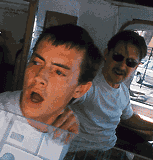The Los Angeles Independent Film Festival continues to grow and thrive while providing a high-profile showcase for interesting filmic fare.
In keeping with the festival's community-based spirit, the LAIFF film awards are tallied up from audience ballots. The Indie Supporter Award, however, is accorded to an individual with an exemplary commitment to non-studio moviemaking. Here are this year's honorees.
|
|
|
Directed by Scott Ziehl Produced by Roxana Zal |
|
|
|
Some Girls |
|
|
|
Pants on Fire |
|
|
|
Directed by Adam Collis |
|
|
|
|
In its fourth year, the Los Angeles Independent Film Festival (LAIFF) solidified itself as a viable venue for the newest in American independent cinema by entrenching its presence in the heart of Hollywood. No longer a fledgling fest, the 1998 LAIFF spread itself amongst sites situated on Sunset Boulevard the Directors Guild of America headquarters, the art-house Laemmle Sunset 5 theatres, the Laugh Factory and the Harmony Gold Theater. Ever expanding, the five-day event (held from April 16 to 20) embodied a roster of 28 features and 35 shorts. This time around, the LAIFF was ushered in by Susan Styron's pastoral, Civil War-era yarn Shadrach, based on the short story by the director's father, William Styron, while the kooky, romantic hijinx of writer/director Noah Baumbach's Mr. Jealousy capped the ceremonies. The Artist Rights Foundation also sponsored a special screening of Sydney Pollack's government thriller Three Days of the Condor (photographed in Panavision anamorphic by Owen Roizman, ASC), followed by a panel discussion with its creative collaborators. Along with its New Media Forum and Craft Series intensive seminars in acting, writing, directing and production design the LAIFF presented the third annual Kodak Close-Up cinematography series, with sessions conducted by Victor Kemper, ASC and Amy Vincent (Eve's Bayou). Of the entries in this year's LAIFF, the pictures Broken Vessels and Scotch and Milk boasted especially impressive imagery which belied their less-than-bounteous budgets.
BROKEN VESSELS
Director: Scott Ziehl
Cinematographer: Antonio Calvache
Broken Vessels looks at the gradual descent of two ambulance drivers, Tom (Jason London) and Jimmy (Todd Field), into an increasingly drug-infused world. In shooting this tale which plays like a cross between Trainspotting and the Seventies TV drama Emergency director Scott Ziehl and cinematographer Antonio Calvache had three basic tenets: to convey the protagonists' transformation through pro-gressively stylized imagery; endow scenes with realism and credibility, avoiding the traditional tropes used to visualize drug abuse; and make the numerous ambulance sequences as varied and interesting as possible.
The filmmakers achieved the devolution of the paramedics through the use of two contrasting shooting styles. "Basically we wanted a dual look [which combined] a handheld, documentary style and a more traditional, stately style," explains Ziehl, who directed, co-wrote, and produced the film."As the story progresses, the camera moves become increasingly frenetic, with more movement and stranger angles."
Calvache, an alumnus of the American Film Institute, also had to create a look for two other types of scenes as well: a series of flashbacks, and several video sequences shot by Tom from the ambulance's passenger seat. The flashbacks were originally slated to be shot in Pennsylvania (the location of Tom's hometown), but the film's budget prohibited the production from moving to the East Coast. "Because there is nothing nearby L.A. that looks like Pennsylvania, we had to forget the realistic approach and substitute the lack of information in the landscape with the increasing emotional effect of the scene, achieved by a visual approach unique to these flashback scenes," explains Calvache. "I had experimented in still photography with a technique I term 'negative diffusion', which is using diffusion in the printing process from negative to positive, as opposed to diffusion used in the camera during exposure of the negative. I had used it for music videos during telecine, but it gets more complicated with film. We had to use an optical printer, and place a diffusion filter in front of its lens for that same footage. We increased the contrast by using a mix of interpositive and release stocks in the duplicate process." The resulting effect is a series of images that seem simultaneously brilliant and washed-out, like an overwhelming memory that is being painstakingly repressed.
For the video sequences, Calvache utilized a Hi-8 camera. "The first transfer from video to film looked terrible," he says. "It was okay that you could tell it was video that was the purpose but the colors were too faded. The main problem with this video footage was that the blacks were really not black."
Ultimately, Calvache managed to beautify the video footage when subjecting the entire film to a silver retention process. "Theoretically, silver retention decreases the amount of color saturation," he says. "However, we used it at a subtle level, so colors were not apparently affected, but a layer of texture was added to the film. This process provided us with a more gritty and thus more real look, a bit like black-and-white. The silver retention added contrast and darkness in the blacks — it made the film look 'stronger.'"
[ continued on page 2 ]
